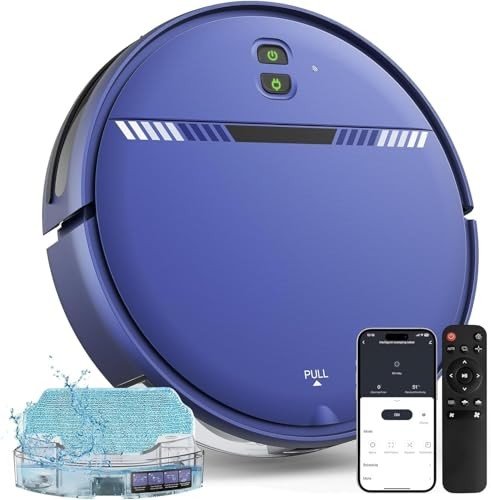The Rise of Robot Vacuum Cleaners in Industrial Settings
In the last few years, the landscape of industrial cleaning has witnessed a considerable change with the intro of robot vacuum cleaners. These automated devices are not just a novelty for homes; they have gotten traction in storage facilities, manufacturing plants, and other industrial environments. best robot floor cleaner out the performance, benefits, and considerations of robot vacuum cleaners within the industrial context, while responding to some regularly asked questions.
What are Robot Vacuum Cleaners?
Robot vacuum are automated cleaning devices geared up with advanced sensors and technology that allow them to navigate around areas, discover dirt, and vacuum surfaces without direct human intervention. In best roborock vacuum , they are developed to deal with a variety of debris types, facilitate routine cleaning schedules, and improve total operational performance.
Table 1: Key Features of Industrial Robot Vacuum Cleaners
| Function | Description |
|---|---|
| Navigation | Uses LiDAR or camera-based navigation for exact mapping. |
| Size and Design | Compact and robust style to fit in tight spaces and endure hard environments. |
| Self-Charging | Immediately returns to its docking station for charging. |
| Dustbin Capacity | Bigger dustbin matched for industrial debris sizes and volumes. |
| Programming | Can be configured for scheduling and specific cleaning jobs. |
| Data Collecting | Equipped with sensors to collect data for maintenance and cleaning analysis. |
Benefits of Robot Vacuum Cleaners in Industrial Settings
The adoption of robot vacuum comes with a myriad of advantages:
Increased Efficiency:
- 24/7 Operation: Unlike human cleaners, robots can operate around the clock, contributing to constant cleanliness without downtime.
- Time-Saving: Automated cleaning allows staff members to focus on core tasks rather than cleaning tasks.
Expense Savings:
- Labor Costs: Maintaining a robot vacuum can decrease the need for a large cleaning staff, lowering general labor costs.
- Functional Efficiency: With enhanced tidiness and lowered downtime due to upkeep concerns, organizations can save on functional costs.
Boosted Safety:
- Reduced Risk: By minimizing the human involvement in dangerous cleaning environments, the threat of accidents is lessened.
- Constant Cleaning: Robot vacuums guarantee that areas are regularly cleaned, lowering slip risks and unhealthy environments.
Increased Flexibility:
- Customizable Cleaning Routes: These devices can be programmed to tidy specific locations or floorings, adapting to changing industrial layouts.
- Variety of Surfaces: Industrial robot vacuums can manage numerous flooring types, from concrete to tiles, making them versatile.
Environmental Impact:
- Sustainable Cleaning Solutions: Many models use very little water and eco-friendly cleaning options, aiding in business sustainability efforts.
Table 2: Industrial Applications of Robot Vacuum Cleaners
| Industry | Application |
|---|---|
| Production | Cleaning production lines and assembly areas. |
| Warehousing | Maintaining clean and organized storage spaces. |
| Food Processing | Making sure cleanliness in delicate areas to satisfy hygiene standards. |
| Pharmaceuticals | Keeping ultra-clean environments for production. |
| Logistics and Distribution | Keeping pathways clear for efficient operation. |
Difficulties and Considerations
While the advantages are considerable, companies must also consider several challenges:
- Initial Investment: The in advance expenses of buying industrial robot vacuum cleaners can be considerable, though long-term savings might offset this expenditure.
- Repair and maintenance: Regular maintenance is vital to keep the robotic systems functioning optimally, and repairs can sustain additional costs.
- Combination: Businesses might need to integrate these makers into existing workflows, which can require time and change.
- Training and Support: Staff might require training to successfully handle these machines, especially when troubleshooting or shows is required.
FAQs About Robot Vacuum Cleaners in Industrial Settings
1. How much do industrial robot vacuum cleaners cost?
The expense can vary from a few thousand to tens of thousands of dollars, depending on requirements, features, and brand name.
2. What types of surface areas can they clean?
Robot vacuum cleaners are suitable for various surface areas consisting of carpets, tiles, concrete, and even some wood floors.
3. How do they browse intricate industrial environments?
Many industrial robot vacuums make use of sophisticated navigation systems like LiDAR, cameras, and sensing units to draw up and adjust to their surroundings for effective cleaning.
4. Can they clean up large areas without human intervention?
Yes, industrial robot vacuums are created to tidy substantial areas with pre-programmed paths and schedules, efficiently running autonomously.
5. Are these robots eco-friendly?
Numerous models prioritize efficiency and lower water use, making them a more ecologically friendly cleaning option compared to conventional techniques.
The intro of robot vacuum cleaners into industrial environments symbolizes an amazing improvement in cleaning technology. With their capability to boost efficiency, minimize labor expenses, and preserve security, these automated systems are paving the method for smarter and cleaner industrial operations. While challenges might exist, the long-lasting benefits and technological improvements are encouraging for industries seeking to improve their cleaning procedures. As technology continues to develop, we can anticipate further developments in robot vacuum that will change industrial cleaning practices even more.

